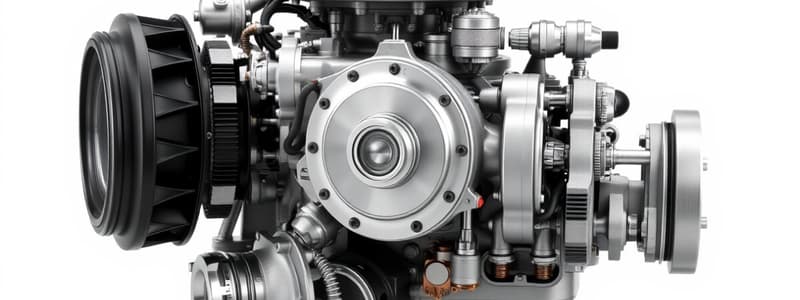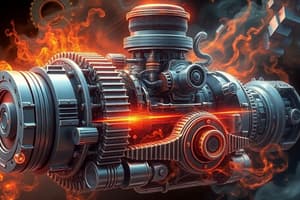Podcast
Questions and Answers
What should a student be familiar with after completing this course?
What should a student be familiar with after completing this course?
The engine and its parts.
What is one of the systems students need to identify in the engine?
What is one of the systems students need to identify in the engine?
The role of each system or subsystem.
What type of engine is discussed in Chapter 1?
What type of engine is discussed in Chapter 1?
- Diesel Engine
- Electric Engine
- Otto Engine with Two Strokes
- Otto Engine with Four Strokes (correct)
Which of the following topics is covered in Chapter 1?
Which of the following topics is covered in Chapter 1?
What does the pressure-volume diagram represent?
What does the pressure-volume diagram represent?
The cylinder numbering and firing order are covered in Chapter 1.
The cylinder numbering and firing order are covered in Chapter 1.
What are the examples of engine parts mentioned in Chapter 2?
What are the examples of engine parts mentioned in Chapter 2?
Match the following parts of the engine to their descriptions:
Match the following parts of the engine to their descriptions:
What type of engine is discussed in Chapter 3?
What type of engine is discussed in Chapter 3?
What is a characteristic of the two-stroke Otto engine?
What is a characteristic of the two-stroke Otto engine?
What is one advantage of the two-stroke Otto engine?
What is one advantage of the two-stroke Otto engine?
Flashcards are hidden until you start studying
Study Notes
Course Objectives
- Familiarization with engine components and their functions.
- Identification of the role of each engine system and subsystem.
Chapter 1: Four-Stroke Otto Engine
- Structure and Functioning: Understand the configuration and operation of a four-stroke Otto engine.
- Physical and Chemical Principles: Explore the fundamental principles governing engine performance and operation.
- Work Diagram: Analyze the pressure-volume (P-V) diagram that illustrates engine cycles.
- Distribution Diagram: Review diagrams related to valve timing and engine cycle synchronization.
- Cylinder Numbering and Firing Order: Learn how cylinders are numbered and the importance of firing order in engine dynamics.
- Engine Characteristic Curves: Study the performance characteristics depicted in various engine curves.
- Aspect Ratios: Investigate the significance of stroke/bore ratios, cylinder power, and mass/power relationships in engine design.
Chapter 2: Engine Components
- Pistons: Examine piston design, movement, and their role in compressing air-fuel mixtures.
- Connecting Rod (Bielle): Understand the connecting rod's function in transferring motion from the piston to the crankshaft.
- Crankshaft (Vilebrequin): Investigate how the crankshaft converts linear motion into rotational motion.
- Dual-Mass Flywheel: Learn about the dual-mass flywheel's role in damping vibrations and improving engine smoothness.
- Cylinder and Cylinder Head: Explore the structure and functions of the cylinder and cylinder head in combustion.
- Valvetrain (Distribution): Study the operation of valves, including timing and control of airflow in the engine.
- Variable Geometry Distribution: Delve into advanced valve timing mechanisms that enhance engine efficiency.
Chapter 3: Two-Stroke Otto Engine
- Construction: Analyze the design differences between two-stroke and four-stroke engines.
- Operation: Understand the operational cycle of the two-stroke engine and its unique processes.
- Control Modes: Review various methods for controlling engine operation and efficiency.
- Construction Characteristics: Identify specific features and construction techniques unique to two-stroke engines.
- Advantages and Disadvantages: Assess the pros and cons of the two-stroke Otto engine compared to its four-stroke counterpart.
Studying That Suits You
Use AI to generate personalized quizzes and flashcards to suit your learning preferences.




